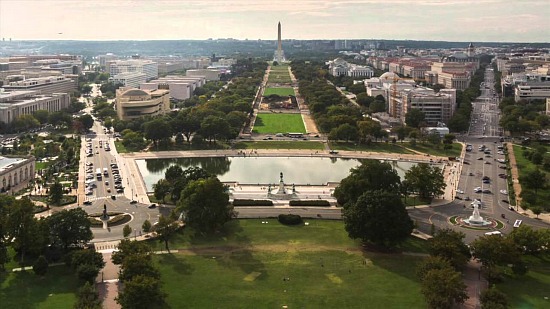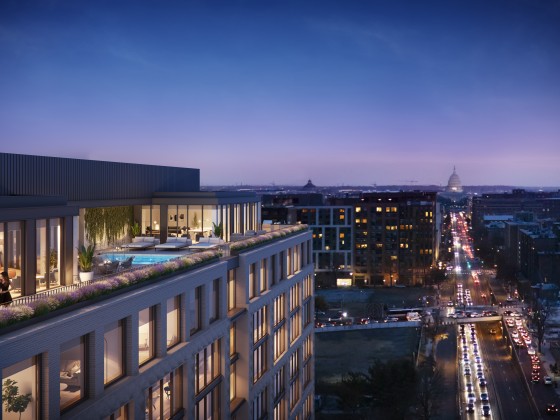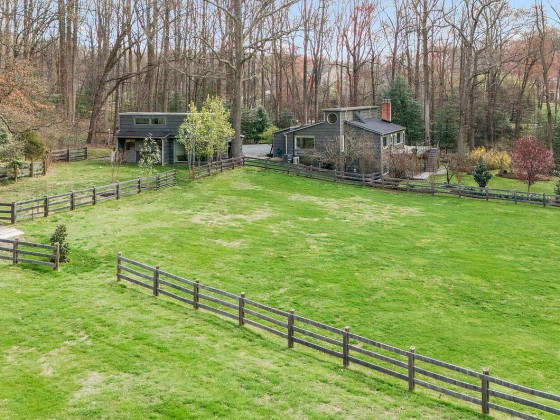 DC Residents Won't Be Living Sky High Just Yet
DC Residents Won't Be Living Sky High Just Yet

When developers head before the Board of Zoning to get approval for a building’s height, they can often be heard assuring the board of one thing: The rooftop structures are just mechanical.
That should soon change. A tweak to the Height Act signed into law in mid-May made it possible for DC’s rooftops to be homes not just to cooling equipment, stair towers and elevator shafts; now, developers can build a residential penthouse on a rooftop up to the height that mechanical penthouses were previously allowed: 20 feet.
Or they will be able to, under the new law. But the Zoning Commission (ZC) and the Office of Planning (OP) haven’t quite figured out how to rewrite the zoning code yet. Until then, anxious developers ready to seize on the change have to sit tight.
On Monday, in a meeting before the ZC, the Office of Planning submitted a few ideas for how the new regulations might shake out. They are as follows:
- Allow rooftop penthouses to go up to 20 feet.
- Permit two levels within those penthouses, so long as the structure is below the Height Act limit.
- Eliminate limits on how much of the roof a structure can occupy, and Floor Area Ratio (FAR) requirements, and instead just use the current rooftop mechanical penthouse requirement of a 1:1 ratio to control how far back on the roof a structure must be.
- Allow all forms of habitable space on rooftops, meaning the Board of Zoning Adjustment or Zoning Commission won’t have to make decisions based on what and how a penthouse structure will be used.
- Link the penthouse program to affordable housing requirements, so that building a penthouse requires at least some contribution to an affordable housing program.
The Office of Planning asked the ZC to consider these requirements and set them down earlier this week. Planning’s Joel Lawson said the rush to finish the rules was due in part to developers’ interest in incorporating the changes into their existing projects.
“Our concern is that there are a lot of people out there who are very confused about what they can do with their penthouses,” Lawson said at the meeting. The Office of Planning’s document outlining the proposed changes expressed a “pressing need” to change the rules to comply with the new law.
But as the Washington Business Journal previously reported, the Zoning Commission declined to vote on the rules and instead asked Planning to draft more specific language before moving forward with any decisions.
In Monday’s hearing, Peter May, who represents the National Park Service’s interests on the ZC, expressed the strongest concerns about the new language, questioning the maximum height and suggesting it be brought down to 18’ 6”. May also recommended including the penthouses in FAR requirements, which would reduce the overall density of a project; including setback requirements from the side of a building as well as the front of a building; and strongly tying the penthouses to affordable housing. He also said developers should be incentivized to provide community amenities on rooftops where possible.
The Office of Planning’s acting director, Ellen McCarthy, told UrbanTurf that given the commissioners’ interest in an affordable housing link, the proposed language may tie the penthouses to affordable housing in some way. In that scenario, the developer would either make a contribution to the Housing Production Trust Fund or partner with a non-profit to develop a commensurate amount of affordable housing, she said.
McCarthy also hypothesized that the ZC may end up requiring developers to come in for a cursory review before proceeding with building “matter-of-right” residential penthouses.
“Given the sensitivity of some of the Zoning Commission members to the visual impact of roof structures, they might require a design review similar to what is now required for buildings along the waterfront, Half Street or M Street in the Capitol Gateway overlay district,” she told UrbanTurf. “It’s generally very quick, and the Commission just reviews the site plans to make sure that the proposed structure is compatible with the goals and objectives for that area.”
So, what’s up next? The ZC will consider Planning’s actual text in September before opening up the new rules to public comment. (McCarthy says Lawson can be contacted for questions before then.) But for now, developers can’t act on the new rules — and there is no set date when the new rules will be in place. And though Planning expressed a sense of urgency, May didn’t seem overly concerned with developers’ timelines.
“The zoning regulations are what they are right now and they can do what they can right now,” he said at the meeting. “We’re only talking about 30 days. The Height Act’s been around for 100 years.”
See other articles related to: height act, penthouse, penthouses, residential penthouses
This article originally published at https://dc.urbanturf.com/articles/blog/federal_change_to_the_height_act_makes_residential_penthouses_legal...but_n/8814.
Most Popular... This Week • Last 30 Days • Ever

DC's homebuyer assistance programs can be a bit complex. This edition of First-Timer ... read »

In this article, UrbanTurf looks at the estimated annual maintenance costs associated... read »

Plans for the development at a prominent DC intersection began nearly eight years ago... read »

Today, UrbanTurf is examining one of our favorite metrics regarding competition in th... read »

Airbnb's push to build condos; the Virginia town that Gen-X loves; and Ohtani's Hawai... read »
DC Real Estate Guides
Short guides to navigating the DC-area real estate market
We've collected all our helpful guides for buying, selling and renting in and around Washington, DC in one place. Start browsing below!
First-Timer Primers
Intro guides for first-time home buyers
Unique Spaces
Awesome and unusual real estate from across the DC Metro













